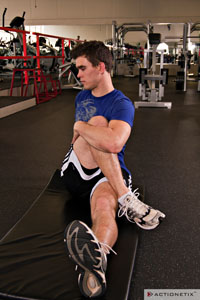Stretch for Success
Doing your time on the treadmill, staying away from the deep fryer and lifting some free weights to build your functional strength are common in almost any sport’s off season. Stretching on the other hand can sometimes go by the wayside. Stretching is an essential component to success in the action sports world. Speeds are faster, your competition is more prepared and the element of danger is always present. Training your muscles to extend past their normal range of motion is of great benefit, particularly if you happen to end up in a situation where you hit the ground in an early season race. A well-conditioned muscle that has an extended range of motion from consistent stretching may be able to withstand the forces of a crash without tearing… which is of course a blessing.
Above and beyond injury prevention, stretching has a number of key benefits such as reduction of tension, enhanced muscular coordination, improved circulation, and increased energy due to the increased blood flow. Knowing that there a numerous benefits to stretching, there are also various “types” or adaptations to stretching which can been seen in the following list:
- Static stretching
- Ballistic stretching
- Dynamic stretching
- Active stretching
- Passive (or relaxed) stretching
- Isometric stretching
- PNF stretching
The main type that we’ll focus on here is static stretching. I’ve chosen to focus on this type of stretching because it can be performed without the help of a partner, and it’s suitable for all ages and fitness levels.
Static stretching is when an individual performs a stretch and hold it in one position. For instance when you stretch your hamstring (back of your upper leg), you will get into the stretch and then hold the position. This is contrary to some of the other stretching techniques such as ballistic stretching where athletes move their joints in order to improve range of motion. Sprinters are commonly seen performing ballistic stretching when they are preparing to race.
The Stretch Reflex
All of your muscles are equipped with a built in stretch reflex, which is designed to control the length of your muscles, by contracting them as they approach their limit. You can feel the stretch reflex at work as your muscle tightens as it is stretched further. The muscle get’s hard, and you start to experience pain. Working in this zone while stretching is the key to increasing your flexibility. Allowing your mind and body to relax at the point where mild pain starts during the stretch will allow you to slowly overcome the stretch reflex. Easing in and through a stretch is critical to elongating the muscle fibers without injuring the muscle(s) being stretched.
When performing a stretch and working through the stretch reflex, it’s important to hold the stretch for at least 30 seconds, but recommended for 30-45 seconds. Once during the 45 seconds, you can gently back off the stretch and then apply the stretch slightly further, making the muscle longer. Consistent, repetitive stretching will allow your muscles to get longer over time, which has enormous benefits that translate directly to your riding.
Top 5 Commandments of Stretching
- Stretch in a quiet, comfortable place in order to allow you muscles to relax and optimize each stretch
- Warm up for 5-10 minutes on a bike or treadmill before you start stretching
- Breathe deep and exhale while stretching to allow total body relaxation
- Practice stretching consistently at least 3 times/week
- Hold a stretch for 45-60 seconds to allow yourself a chance to overcome the stretch reflex
